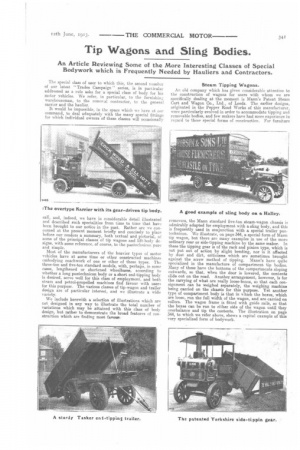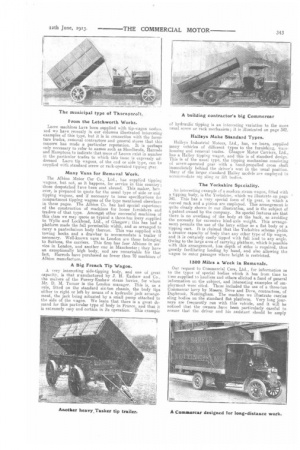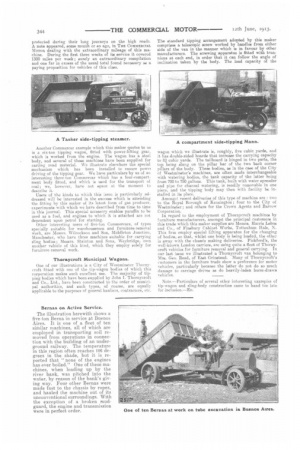Tip Wagons and Sling Bodies.
Page 19

Page 20

Page 21

Page 22

If you've noticed an error in this article please click here to report it so we can fix it.
An Article Reviewing Some of the More Interesting Classes of Special Bodywork which is Frequently Needed by Hauliers and Contractors.
The special class of user to which this, the second number of our latest "Trades Campaign" series, is in particular addressed as a rule asks for a special class of body for his motor vehicles. We refer, in particular, to the furnishin,r warehouseman, to the removal contractor, to the general carrier and the haulier.
It would be impossible, in the space which we have at our command, to deal adequately with the many special fittings for which individual owners of these classes will occasionally call, and, indeed, we have in considerable detail illustrated and described such specialities from time to time that have been brought to our notice in the past. Rather are we concerned at the present moment briefly and concisely to place before our readers a summary, both textual and pictorial, of some of the principal classes of tip wagons and lift-body designs. with some reference, of course, to the pantechnicon pure and simple.
Most of the manufacturers of the heavier types of motor vehicles have at some time or other constructed machines embodying coachwork of one or other of these types. The three-ton and five-ton standard models, with, perhaps, in some cases, lengthened or shortened wheelbase*, acoording to whether a long pantechnicon body or a short end-tipping body is desired, serve well for this class of employment, and both steam and petrol-propelled machines findfavour with users for this purpose. The various classes of tip-wagon and trailer design are of particular interest, and we illustrate a wide variety.
We include herewith a selection of illustrations which are not designed in any way to illustrate the total number of variations which may be attained with this class of body design, but rather to demonstrate the broad features of construction which are finding most favour.
Steam Tipping Wagons.
An old company which has given considerable attention to the construction of wagons for users with whom we are specifically dealing at the moment is Mann's Patent Steam Cast and Wagon Co., Ltd., of Leeds. The earlier designs, originated in the Pepper Road Works of this manufacturer, were particularly evolved in order to accommodate tipping and removable bodies, and few makers have had more experience in reeard to these special forms of construction. For furniture
removers, the Mann standard five-ton steam-wagon chassis is admirably adapted for employment with a sling body, and this is frequently used in conjunction with a special trailer pantechnicon. We illustrate, on page 344, a special form of Mann tip wagon, but there are many examples in use of the more ordinary rear or side-tipping machine by the same maker. In these the tipping gear is of the rack and pinion type, which is not put out of action by slight bending, nor is it affected by dust and dirt, criticisms which are sometimes brought against the screw method of tipping. Mann's have quite specialized in the manufacture of compartment tip bodies. Many of these have the bottoms of the compartments sloping outwards, so that, when the door is lowered, the contents slide out on the road. Another arrangement, however, is for the carrying of what are really loose-boxes, so that each consignment can be weighed separately, the weighing machine being carried on the chassis for this purpose. Yet another type of compartment body is that in v. hich the boxes, which are loose, run the full width of the wagon, and are carried on rollers. The wagon frame is fitted with guide rails, so that the boxes can be run to either side of the wagon until they overbalance and tip the contents. The illustration on page 344, to which we refer above, shows a capital example of this very specialized form of bodywork.
A Tasker trailer with side-tipping compartments. Trailer Specialists
The "Little Giant" wagons, manufactured by W. Tacker and Sons, Ltd., are frequently fitted with tip bodies, either of the side or the end-tipping variety. We illustrate one of these. As a rule the tipping gear consists of a hand-operated screw device of the usual type. Tasker's have a special reputation in respect of their trailer construction ; Tacker trailers, as a matter of fact, are found all over the country, and not infrequently even behind engines and steam wagons of other makes. We rcproduca a selection of photographs which gives an excellent idea of the special class of work which is embodied in these trailers. These pictures show clearly the end and side-tipping arrangements which are frequently embodied in them. They are altogether of a very robust form of construction, and find considerable favour with users of all kinds.
A special tip compartment wagon, constructed as a trailer, is another Tacker speciality; this is frequently supplied for colliery purposes. The five-ton or six-ton end-tipping wagon has the usual screw-operated gear, while the side-tipping trailer has a rack at each end of the body, operated by a pinion; it can be tipped to either side.
For the Crown Agents.
An interesting example of a number of tip wagons which have been constructed by Dennis Bros., Ltd., is one supplied to the Crown Agents for the Colonies, and we illustrate it herewith.
This manufacturer has had a very great experience in regard to the supply of special bodies for warehousemen and general hauliers, and has constructed all the usual forms of sling bodies, pantechnicon bodies, etc., etc.
Overtype Chassis Accommodate Tips.
The Karrier car, manufactured by Clayton and Co., Huddersfield, Ltd,, is, as our readers are aware, designed in two
distinct types, one in which the engine is located beneath the driver's seat, and the other in which it is under the more conventional bonnet. The former type offers special facilities for the convenient accommodation of tip bodies and coachwork of especially ample. dimensions, such as that required by furniture warehousemen. etc. Clayton's construct a patent mechanical tipping gear : this is operated hr a chain drive from a sprocket mounted on the end of the differential shaft. An automatic trip motion is provided to prevent over winding in either direction, by means of a bell-crank lever and a rod declutching the sprocket on the differential shaft, which operates the tipping gear. It is claimed that a fiveton load can be tipped in 30 seconds. The standard Karrier side-tipping body has its bottom inclined on either side, and automatically tips the contents when the locking bar which holds the sides in position is released, An interesting example of the side-tipping wagon with four compartments has been supplied to the Priestman Colliery Co., of Newcastle-on-Tyne. Each compartment holds 15 cwt. of coal, and the machine is specially employed for the delivery of coal to the miners' homes. We illustrate it below.
From the Letchworth Works.
Lacre machines have been supplied with tip-wagon oodles:. and wa have recently in our columns illustrated interesting examples of this type, but it is in connection with the furniture trades, removal contractors and general stores that this concern has made a particular reputation. It is perhaps only necessary to refer to names such as Shoolbrois, Harrods and Hamptons to indicate that users of Lacres exist in number in the particular trades to which this issue is expressly addressed Lacre tip wagons, of the end or side type, can be supplied with standard screw or rack-operated tipping oar.
Many Vans for Removal Work.
The Albion Motor Car Co., Ltd., has supplied tipping wagons, but not, as it happens, for service in this country ; those despatched lave been sent abroad. This maker, how• ever, is prepared to quote for the usual type of side or endtipping wagons, and if necessary to issue specifications for compartment tipping wagons of the type mentioned elsewhere in these pages. The Albion Co. has had special experience of the construction of machines for house furnishers and traders of that type. Amongst other successful machines of this class we may quote as typical a three-ton lorry supplied to Wylie and Lockhead, Ltd., of Glasgow ; this has had a platform made the full permissible width, and so arranged to carry a pantechnicon body thereon. This was supplied with towing hooks and a drawbar to accommodate a trailer if necessary. Well-known vans in London are those belonging to Suttons, the carriers. This firm has four Albions in ser• vice in London, and another one in Manchester ; they have an exceptionally high body, and are remarkable for that fact. Harroda have purchased no fewer than 70 machines of manufact Lac.
A Big French Tip Wagon.
A very interesting side-tipping body, and one of great capacity, is that tranufactured by J. H. Exshaw and Co., the makers of the Purrey-Exshaw steam lorries, for whom Mr. D. M. Turner is the London manager. This is, as a rule, fitted on the standard six-ton chassis, the body tips either to right or left by means of a hydraulic jack arrangemeat, the jack being actuated by a small pump attached to the side of the a agon. We learn that there is a great demand for this particular type of body in France, and that it is extremely easy and certain in its operation. This example of hydraulic tipping is all interesting variation to the more usual screw or rack mechanism; it is illustrated on page 342.
Halleys Make Standard Types.
Halleys Industrial Motors, Ltd., has, we learn, supplied many vehicles of different types to the furnishing, warehousing and remos-al trades. orlasgow Motor Carriers, Ltd., has a Halley tipping wagon, and this is of standard design. This is of the usual type, the tipping mechanism consisting of screw-operated gear with a hand-propelled cross shaft immediately behind the driver's seat in the usual position. Many of the larger standard Halley mcdels are employed to accommodate nig sling or lift bodies.
The Yorkahire Speciality.
An interesting example of a modern steam wagon, fitted with a tipping body, is the Yorkshire, which we illustrate on page 341. This has a very special form of tip gear, in which a curved rack and a pinion are employed. This arrangement, is quite clearly shown in our illustration, and is the subject of a patent owned by the company. Its special features are that there is no overhang of the body at the back, so avoiding the necessity for excessive hind-axle weight. This arrangement permits the use of the lorry either as a flat body or a tipping cart. It is claimed that the Yorkshire scheme yields areater capacity of body than any other type of tip wagon, and it is certainly easily tipped with full load to any angle. Owing to the large area of carrying platform, which ia possible with this arrangement, lass depth of sides is required, thus greatly facilitating loading by hand, and also allowing the wagon to enter passages where height is restricted.
1300 Miles a Week in Removals.
Our request to Commercial Cars, Ltd., for information as to the types of special bodies which it has from time to time supplied to hauliers and others elicited a fund of general information on the subject, and interesting examples of employment were cited. These included the use of a three-ton Commercar lorry by Messrs. Dove and Dove, contractore, of Daybrook, Nottingham. The machine we illustrate carries sling bodies on the standard flat platform. Very long journeys are frequently run with this vehicle, and it will be noticed that the owners -have been particularly careful to ensure that the driver and his assistant shoidd be amply protected during their long journeys on the high roads. A note appeared, some month or so ago, in THE COMMERCIAL MOTOR dealing with the extraordinary mileage of this machine. During the first three weeks of its service it covered 1300 miles per week ; surely an extraordinary compilation and one far in excess of the usual total found necessary DA a paying proposition for vehicles of this class.
Another Commercar example which this maker quotes to us is a six-ton tipping wagon, fitted with power-lifting gear, which is worked from the engine. The wagon has a steel body, and several of these machines have been supplied for carting road material. We illustrate elsewhere the special mechanism which has been installed to ensure powei driving of the tipping gear. We have particulars by us of an interesting three-ton Commercar which has a four-compartment body fitted, and which is used for the transport of coal ; we, however, have not space at the moment to describe it.
Users of the kinds to which this issue is particularly addressed will be interested in the success which is attending the fitting by this maker of its latest form of gas producer, experiments with which we have described from time to time in this journal. This special accessory enables paraffin to be used as a fuel, and engines to which it is attached are not. dependent upon petrol for starting. Other interesting users of five-ton Commercars, of types specially suitable for warehousemen and furniture-removal work, are Messrs. Wilcockson and Son, Middleton Junction, Manchester, who have three machines suitable for carrying sling bodies; Messrs. Stainton and Sons, Weybridge, own another vehicle of this kind, which they em-ploy solely for furniture-removal work.
Thornycroit Municipal Wagons.
One of our illustrations is a City of Westminster Thornycroft fitted with one of the tip-wagon bodies of which this corporation makes such excellent use. The majority of tipping bodies which have been supplied by John I. Thornycroft and Co., Ltd., have been constructed to the order of municipal authorities, and such types, of course, are equally applicable to the purposes of general hauliers, contractors, etc.
Bernas on Active Service.
The illustration herewith shows a five-ton Berna in service at Buenos Aires. It is one of a fleet of ten sithilar machines, all of which are employed in transporting soil removed from operations in connection with the building of an underground railway. The temperature in this region often reaches 106 degrees in the shade, but it is reported that "none of the engines has ever boiled." One of these machines, when loading up by the river bank, was pitched into the water, by reason of the bank's giving way. Four other Bernas were made fast to the chassis by ropes, and hauled the machine out of its unconventional surroundings. With the exception of a broken mudguard, the engine and transmission were in perfect order.
The standard tipping arrangement adopted by this maker comprises a telescopic screw worked by handles from either side of the van in the manner which is in favour by other manufacturers. The screwing apparatus is fitted with trunnions at each end, in order that it can follow the angle of inclination taken by the body. The load capacity of the
wagon which we illustrate is, roughly, five cubic yards, and it has double-sided hoards that increase the carrying capacity to 81 cubic yards. The tailboard is hinged in two parts, the top being slung on the pillar bar of the two back corner pillars of the body. These bodies, as in the case of the City of Westminster's machines, are often made interchangeable with watering bodies, the tank capacity of the latter being from 700 to 750 gallons. This tank, built with water spreader and pipe for channel watering, is readily removable in one piece, and the tipping body may then with facility be installed in its place.
Amongzt recent deliveries of this type of machine are : two to the Royal Borough of Kensington ; four to the City of Westminster ; and others for the Crown Agents and Barrow Corporation.
In regard to the employment of Thornycroft machines by furniture manufacturers, amongst the principal customers in this trade which this maker supplies are Messrs. Harris Lebus and Co., of Finsbury Cabinet Works, Tottenham Hale, N. This firm employ special lifting apparatus for the changing of bodies, so that, whilst one body is being loaded, :the other is away with the chassis making deliveries. Pickford's, the well-known London carriers, arc using quite a fleet of Thornycroft vehicles for furniture removal and general carrying. In our last issue we illustrated a Thornycroft van belonging to Mrs, Geo. Read, of East Grinstead. Many of Thornycroft's customers in the furniture trade show a preference for motor vehicles, particularly because the latter do not do so much damage to carriage drives as do heavily-laden horse-drawn vehicles.
Note.—Particulars of several other interesting examples of tip-wagon and sling-body construction came to hand too late for inclusion.—En.






























